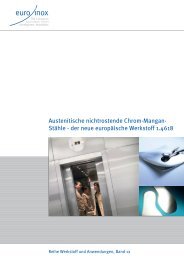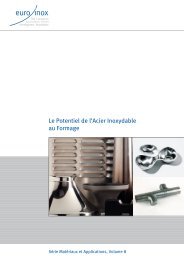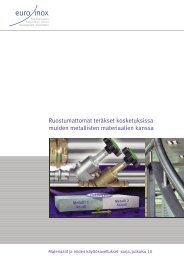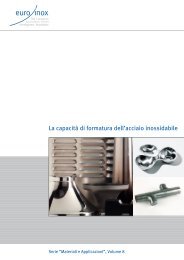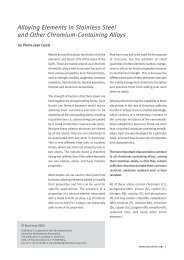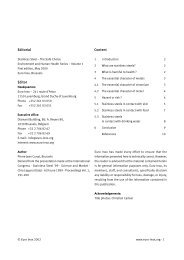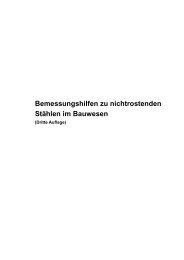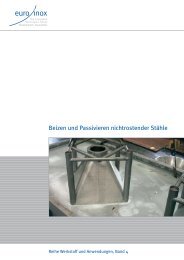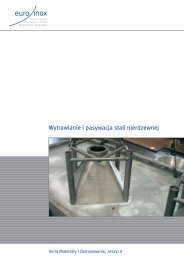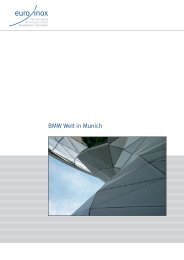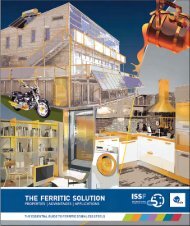Innovative Stainless Steel Applications in transport ... - Euro Inox
Innovative Stainless Steel Applications in transport ... - Euro Inox
Innovative Stainless Steel Applications in transport ... - Euro Inox
You also want an ePaper? Increase the reach of your titles
YUMPU automatically turns print PDFs into web optimized ePapers that Google loves.
5.2 Sandwich panel mechanical properties<br />
The mechanical test<strong>in</strong>g programme carried out <strong>in</strong> the DOLTRAC project <strong>in</strong>cluded both<br />
static bend<strong>in</strong>g tests for full-size 1250 mm × 2200 mm panels and fatigue test<strong>in</strong>g of<br />
smaller panel sections, also <strong>in</strong> bend<strong>in</strong>g configuration. Further test<strong>in</strong>g for sections was<br />
carried out <strong>in</strong> the crash test programme, described more <strong>in</strong> detail <strong>in</strong> Chapter 5.3. The<br />
panel details are collected <strong>in</strong> Table 33.<br />
Table 33. The details of the panels manufactured and tested <strong>in</strong> the experimental programme<br />
(DOLTRAC). The top sheet (i.e. the load-side sheet) was similar to all the other panels: 1.9 mm<br />
thick 1.4318 <strong>in</strong> C1000 condition. dim. = RHS tube dimensions or the angle of V(f) core,<br />
dist. = distance between <strong>in</strong>dividual core elements and t = sheet thickness.<br />
Panel type Core Bottom sheet<br />
dim. dist. mat. cond. tc mat. cond. t2<br />
(mm) (mm) (mm)<br />
O-1 20 × 50 84 1.4318 C850 1.0 1.4318 C1000 1.2<br />
O-2 20 × 50 84 304sp 2B 1.0 1.4318 C1000 1.2<br />
O-3 20 × 50 84 1.4318 C850 1.0 1.4318 C850 1.5<br />
O-4 20 × 50 84 304sp 2B 1.0 1.4318 C850 1.5<br />
Vf-1 60 ° 74 1.4318 C850 1.0 1.4318 C1000 1.2<br />
Vf-2 60 ° 74 304sp 2B 1.0 1.4318 C1000 1.2<br />
Vf-3 60 ° 74 1.4318 C850 1.0 1.4318 C850 1.5<br />
Vf-4 60 ° 74 304sp 2B 1.0 1.4318 C850 1.5<br />
V-1 60 ° - 304sp 2B 1.0 1.4318 C1000 1.2<br />
The panels were designed to m<strong>in</strong>imise their weight for the predeterm<strong>in</strong>ed design-load<br />
conditions: a 480 kg/m 2 = 4709 N/m 2 constant load comb<strong>in</strong>ed with a 1.5 kN po<strong>in</strong>t load.<br />
The maximum allowable panel displacement was set at L/300 (6.67 mm for the selected<br />
span length of 2000 mm). Apart from the verification of full-size 1250 mm × 2200 mm<br />
panel properties aga<strong>in</strong>st the design load, the ultimate strength was measured <strong>in</strong> fourpo<strong>in</strong>t<br />
bend<strong>in</strong>g. Smaller, approximately 500 mm × 1000 mm panel samples were tested<br />
<strong>in</strong> three-po<strong>in</strong>t bend<strong>in</strong>g configuration under both static and fatigue load<strong>in</strong>g and<br />
200 - 400 mm × 1800 mm sections <strong>in</strong> quasi-static and crash tests.<br />
The fatigue programme was carried out with the worst case – maximum force<br />
amplitudes for the maximum load cycles (which would not occur <strong>in</strong> reality) – to see if<br />
the test specimens could bear these loads. The selected case was based on a typical<br />
equipment box of ~ 2.5 tons, mounted with eight brackets, <strong>in</strong>duc<strong>in</strong>g a force of 3000 N<br />
per bracket (i.e. a 3 kN po<strong>in</strong>t load) on a 100 × 100 mm 2 square represent<strong>in</strong>g the<br />
underfloor equipment-box bracket. This static load was superposed by ± 20 % dynamic<br />
loads, lead<strong>in</strong>g to R = 0.66 with an upper amplitude of 3600 N and a lower amplitude of<br />
96



